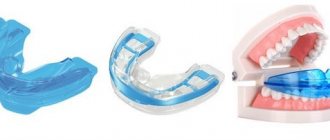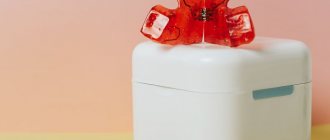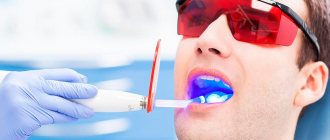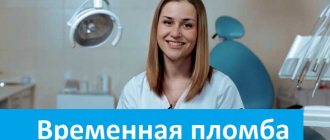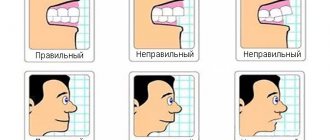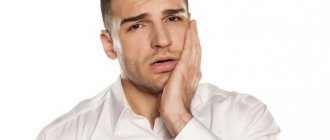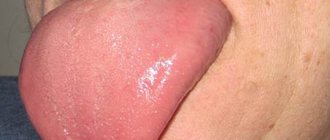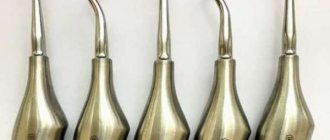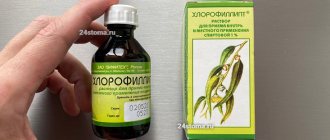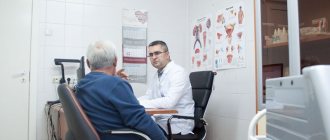What does the trainer look like?
A trainer is a two-jaw mouthguard made of silicone or polyurethane. The design consists of arches for the dentition with recesses for individual teeth, a tongue that corrects the position of the tongue and a lip bumper. Such a device is not made individually; the orthodontist selects a suitable model for the patient. Trainers, depending on the type and manufacturer, may differ in size, width, and length of the arch for the dentition.
Advantages of trainers over other correctors
When analyzing the action and effectiveness of all orthodontic devices for correcting malocclusion, according to the opinions of orthodontists, trainers have three main advantages:
- do not require constant use - the factor of non-aesthetic teeth, which often causes discomfort in society, especially among children, is eliminated;
- lack of pressure on the teeth - the effect is on the entire jaw by limiting the freedom of space, but without the absence of directional pressure;
- ease of installation - the patient can remove and install the trainers independently without additional assistance from a specialist.
Reviews of dental trainers confirm the effectiveness of the design, but only if all operating rules are observed, including indications and treatment regimen. In patients who violate correction tactics (irregularly wearing the device), the treatment result may not correspond to the expected one.
How does the trainer work?
The trainer is put on both rows of teeth, the teeth fall into special recesses. Thus, the jaws and teeth are gently fixed in the correct physiological position - the mouth guard prevents them from taking the usual incorrect position. The device works as a simulator for the masticatory muscles and tongue, teaching them to perform correct, physiological work. An important function of a trainer is to correct and prevent the development of bad habits in children.
The lip bumper prevents unconscious finger sucking in sleep and prevents you from touching your teeth with your hands. The protrusion inside in the center of the arch fixes the tongue in the correct position - does not allow the tongue to remain between the dentition (prevents the formation of an open bite). The massive design itself promotes proper breathing - through the nose.
Indications and contraindications for bite correction using trainers
Important: the indications and possibility of treatment with the help of trainers can only be determined by an orthodontist after a visual examination and hardware diagnostics. Self-indulgence in such a situation can only worsen the situation.
Indications for the use of trainers are:
- crowded growth of the front teeth;
- open bite (lack of contact between the front or side teeth when the jaws close);
- speech defects;
- bad habits (thumb sucking);
- impossibility of using other correction methods for a particular patient.
Treatment with trainers is not possible in the following situations:
- chronic ENT diseases accompanied by severe nasal congestion;
- 3 degree of pathology according to Engle’s classification (lower frontal teeth overlap the upper ones);
- crossbite in the lateral areas of the dentition.
Indications and contraindications for performing a correction course are identified by the dentist at a consultation.
Who is the trainer for?
Trainer for children
The trainer is intended for early treatment of children who still have baby teeth or are just beginning to erupt permanent teeth. The action of the mouth guard is quite mild, so it is effective only for a growing body during the period of active formation of jaws, muscle and teeth growth.
Trainers can be used from about 6 years of age. The mouthguard prevents the formation of dental-facial pathologies, corrects minor curvatures and crowding of teeth, and forms correct habits.
Before and after wearing the trainer for 4 months
Pre-orthodontic trainer
Removable silicone aligners are often used as preparation for subsequent orthodontic treatment with braces, plates or aligners. The pre-orthodontic trainer is used to develop good habits, reinforce the correct position of the tongue, lips and muscle growth.
The complex effect of the device prevents improper growth of teeth and the formation of malocclusion, promotes the development of proper breathing and slightly changes the position of the teeth. Pre-orthodontic trainers are used from the age of 5 and significantly reduce the duration and complexity of treatment with braces in the future. With a simple clinical case and responsible wearing of the trainer, you can do without installing a brace system in the future, but the final conclusion is given by the doctor.
Types of Myobrace Starter pre-orthodontic trainers:
- The initial pre-orthodontic trainer T4K (blue) is a soft device that can adapt to almost any initial position of the teeth.
- The final pre-orthodontic trainer T4K (pink) is a more rigid mouthguard that fixes the result of alignment with the initial trainer into a stable position.
Myobrace trainer with rigid frame
This type of trainer is used during the period of mixed or permanent dentition to correct the position of teeth due to a rigid structure made of nylon and silicone with individual cells for each tooth. The series of trainers is available in 7 sizes for different ages, starting from 10-12 years. Even a hard trainer will not be able to replace braces for complex malocclusions, but it is quite capable of correcting the position of a separate tooth.
Trainer for adults
Mouthguards do not correct bites and uneven teeth in adults because they cannot provide a strong enough mechanical effect on the teeth. Adults may be prescribed trainers as a retention guard after removing braces or as a means of eliminating minor relapses after orthodontic treatment.
Frameless trainer Myobrace
Myobrace No Core Flexible Trainers are most often used as a retention night guard at the end of orthodontic treatment in adults. The device helps improve occlusal contacts and stable teeth position. The trainer is also available in 7 sizes.
Orthodontic treatment methods are the treatment of anomalies in the development of the dental system using special orthodontic devices. At the same time, some irregularities in the shape of the face are eliminated, the acts of chewing, breathing and speech are normalized, irregularities in the location of the teeth, the shape and relationship of the dentition are corrected. Now there are many different orthodontic appliances. One of the most popular nowadays are orthodontic trainers.
Today we’ll talk about orthodontic trainers for teeth, their types, indications for use and much more.
1. What are trainers?
2. Indications.
3. Contraindications.
4. The difference between trainers and other orthodontic devices.
5. Types and models of trainers (orthodontic trays)
6. Proper care.
What are orthodontic trainers ?
Photo of the trainer.
Trainers are removable silicone or polyurethane orthodontic devices (mouth guards, splints) that are designed to correct anatomical bite defects. They can be considered an alternative to brace systems, which should solve the same problems. The main difference from other designs that are used in orthodontics, in addition to their appearance, is that the trainer is designed to eliminate the causes of defects.
Trainers help straighten teeth and eliminate excessive pressure on the maxillofacial muscles or bad habits (tongue sucking, finger sucking) that lead to abnormal bite formation.
An important difference between a trainer and braces or orthodontic plates, which have a mechanical effect on the teeth, is that the splints eliminate the cause of the development of the anomaly, and not its symptoms. In addition, the unique shape of the trainer, made of elastic silicone, gently relieves excessive muscle pressure on the jaws and teeth, making it possible to consolidate the achieved results and eliminate the possibility of relapses.
The purpose of wearing orthodontic trainers is also to bring the tongue into the correct position and form nasal breathing.
Such structures are made from polyurethane of varying hardness, which has the properties of an elastomer. An elastomeric material is one that has very high elasticity. The polymers used are safe as they do not cause allergies.
Main indications for using the trainer: Let's consider anomalies in the development of the dentofacial system, which are indications for wearing the device:
- The inability of a person to use braces for one reason or another;
- malocclusion - deep and open;
- in the frontal part of the lower jaw there is pronounced crowding of teeth;
- some speech therapy problems;
- improper swallowing;
- consolidation of the results of orthodontic treatment;
- rotation of canines and incisors;
- bad habits, such as: sucking the thumb and other objects, inserting the tongue between the lower and upper teeth;
- dental trainers are made from hypoallergenic materials and therefore can be used even by patients prone to allergic reactions;
- psychological problems;
- nasal congestion.
- pain and excessive stress on the TMJ.
Contraindications:
The main disadvantage of trainers is the fact that they may not be effective in all cases. Contraindications for use are: severe nasal congestion, complex cases of malocclusion or dentition. In this state of affairs, it is impossible to correct the anomaly without mechanical action.
The difference between trainers and other orthodontic devices.
The main difference between trainers and other orthodontic devices is their practicality. Unlike braces, they do not need to be worn constantly. They are worn at night and for a couple of hours during the day.
It is also worth noting other advantages:
- easy installation
- the elasticity of the structure does not injure the oral cavity
- convenience and use of the device at night
- invisibility of the device
- minimal discomfort
- easy to care for
- acceptable price
But it is worth noting the minimal number of disadvantages in using these devices:
- it is not possible to talk when the device is installed,
- The final result directly depends on the patient, on his responsibility in regular use of the device,
- low effectiveness for complex anomalies.
How to wear dental trainers?
The device is placed in the oral cavity, the tip of the tongue should be located in the “tongue” of the trainer. Then you need to close your teeth and lips and breathe through your nose.
Types and models of trainers.
There are different classifications of dental trainers, depending on the functionality and purpose of the devices.
According to their functional purpose, trainers are divided into:
- initial ones are soft devices with good elasticity, which allows the patient to quickly adapt. The average lifespan of initial trainers is about 6-8 months, most often they are blue in color.
- the final ones are orthodontic aligners, repeating the shape of the initial ones, but made of less flexible materials. The duration of use of final trainers, as a rule, is also limited to 6-8 months, after which most causes of malocclusion are usually eliminated, usually made of pink silicone or polyurethane.
- retainers - these devices are designed to consolidate the results of orthodontic treatment and prevent relapses.
Trainer models are also classified according to their intended purpose.
The following types of dental trainers are distinguished:
1. trainers for babies TRAINER T4I INFANT
During the formation of the dental system in children, various pathologies often arise. This may be a malocclusion, incorrect position of the lower jaw, crowded teeth, etc. Trainers are a good way to correct such defects in the early stages, as well as to prevent them . These are special silicone splints placed in the oral cavity, which help eliminate the main causes that give rise to these pathologies. Special trainers are produced for children (t4ki INFANT soft (blue) and t4ki INFANT soft (pink) ) from two to five years. They dress for 10 – 15 minutes twice a day. These simulators replenish the load on the oral muscles, help develop the correct position of the tongue when swallowing and at rest, and also eliminate interdental sigmatism. The range of trainers for children from five years of age is designed to consistently eliminate the most common dental development disorders and consolidate the achieved results. They are worn during sleep and for 1 – 2 hours during the day. Trainers for babies are completely safe. They are made of hypoallergenic materials, wearing them is absolutely painless and usually does not cause psychological rejection. They are contraindicated only in case of particularly severe defects of the dental system.
T4K PRE-ORTHODONTIC TRAINERS
Pre-orthodontic trainers T4K blue and T4K pink (red) are widely used by orthodontists to solve the problem of malocclusion from childhood (5-10 years), speech defects and atypical position of the lower jaw.
3. TRAINERS FOR LEVELING T4A
Disturbances in the structure of the dentition are currently one of the most common pathologies of the dental system. Incorrect bite is not only not aesthetically pleasing, but also causes other dental diseases (wearing off enamel, gum disease, difficulties with oral hygiene, impossibility of dentures, etc.)
Currently, special trainers are produced for leveling T4A blue (blue) and T4A pink (red) . These are elastic splints made of silicone that are placed in the oral cavity during sleep and for a short time during the day.
4. TRAINERS WITH MYOBRACE
New orthodontic devices of the Myobrace series with a two-layer design combine the advantages of soft flexible silicone, which forms the outer layer, and a hard inner layer, which forms an elastic frame that stimulates the growth and expansion of the patient’s dental arch. These devices can also be recommended for use during the period of retention when correcting crowding of teeth in the anterior region.
Myobrace series devices are available in 7 sizes:
- Myobrace trainer, size MB1 - distance of the first 4 incisors - 30mm
- Trainer Myobrace, size MB2 - distance of the first 4 incisors - 31.5 mm
- Myobrace trainer, size MB3 - distance of the first 4 incisors - 32.5mm
- Trainer Myobrace, size MB4 - distance of the first 4 incisors - 33.5mm
- Myobrace trainer, size MB5 - distance of the first 4 incisors - 35 mm
- Trainer Myobrace, size MB6 - distance of the first 4 incisors - 36.5 mm
- Myobrace trainer, size MB7 - distance of the first 4 incisors - 38.0 mm.
5. TRAINERS FOR CORRECTION (SERIES I-3; I-3N; I-2; I-2N)
Trainers for dental correction are usually prescribed to children aged 5 years and older, when malocclusions are in their initial stages. The treatment takes place in two stages. At the first stage, soft trainers are prescribed, to which even a small child quickly and easily adapts. The second uses more rigid models designed to consolidate the achieved result. Typically, the mode of wearing trainers is as follows. They are worn at night and for one hour during the day. The initial (soft) trainer is worn for six months, and the final (hard) trainer is worn for six months to a year. The regimen is prescribed by the dentist strictly individually depending on the patient’s characteristics. In cases of bruxism (involuntary grinding of teeth during sleep) or mild disocclusions, they immediately begin with a hard trainer.
LINGUA BRACES T4CII; Т4В
The braces trainer is a modern and reliable device that allows you to solve many of your child’s dental problems. If you want him to grow up healthy and happy, you should pay special attention to his teeth from early childhood. A dental trainer is a great way to quickly and painlessly correct orthodontic problems and give your child a carefree childhood.
The development of malocclusion can be caused by various factors. This can be either bad habits or muscle dysfunction. Therefore, very often after wearing braces, problems return again. As a rule, dental problems begin in children during the active change of milk teeth to molars or later.
Trainers for braces. They serve as an addition to the main treatment of occlusion with braces, and also protect gum tissue from damage by elements of braces; joint trainers. Designed to relieve tension and pain in the jaw muscles.
7. TRAINERS FOR BRUXOGARD BRUXOGARD
The bruxism trainer was designed specifically for children 2-5 years old. It is very easy to use and helps eliminate bad childhood habits such as thumb sucking, interdental tongue thrusting and mouth breathing, and also stimulates the tone of the orbicularis oris muscle and allows children to perform chewing movements to train muscles and stimulate jaw growth - such movements have a cleansing effect. impact on teeth. The trainer cannot be swallowed and can easily be placed in children's mouths; however, the child must be supervised by an adult while using the trainer.
8. TRAINERS TO PREVENT SNORING TMJ-MBV
The new tmj.mbv device features large ventilation holes and a base with air shock absorbers enlarged to 7 mm, allowing lateral and AP movements of the lower jaw during sleep, as well as mild decompression in the TMJ area. Most anti-snoring therapy devices rigidly fix the lower jaw in an anterior position, which can cause damage to the TMJ. The TMJ-MBV splint allows movement of the lower jaw, which is preferable if the patient has TMJ dysfunction.
The sides of this device are much higher than those of a conventional joint splint, which makes its use more comfortable - it does not fall out of the patient’s mouth during sleep. TMJ.MBV allows the patient's lower jaw to be pushed forward, while the height of the bite increases due to the thickness of the base, which helps to increase the lumen of the oropharynx. The device is made of flexible silicone, which allows free movement of the lower jaw during use, making it ideal for TMJ dysfunction.
TMJ AND TMD JOINT SPRINTS
The joint splint has a thickening in the area of the molars, which promotes mild decompression of the joint. Thanks to the flexible silicone base of the splint, a relaxing effect is created on the muscles in the area of the TMJ joint, head and neck, which leads to an immediate reduction in pain. Habits such as bruxism and clenching teeth under stress are limited - tension is relieved thanks to the patented wing-shaped base, as well as the double-jaw design of the splint: in the splint, the lower jaw moves forward. the relative position of the jaws is set according to class I. Over time, this helps eliminate chronic pain in the joint area. The main symptoms of TMJ dysfunction are eliminated within a few days, but to relieve chronic pain, wearing the device for several weeks is required. The joint splint should usually be worn for 1 hour during the day plus overnight. The duration and mode of wearing are individual and should be determined by the attending physician according to indications.
It is not difficult to distinguish the listed types of trainers , since they are indicated by certain markings. For example, dental trainers for adults are T4A, trainers for braces are T4B, trainers for children are T4K and T4Ki. And although such devices are available for free sale, you should not purchase trainers on your own, without a doctor’s recommendation. The fact is that dental trainers should be used as part of an orthodontist-planned treatment that takes into account the patient's specific malocclusions. Only then can you count on getting an effective result.
A diary of daily work with the trainer will be an excellent addition to improve the results of treatment, as well as constant monitoring of wearing trainers
The diary contains additional information on the rules of training trainers. You can also find many useful exercises for the development of the myofunctional system.
The description in the diary is written in a language accessible to children and all exercises are presented in the form of a game.
This diary will help you and your child on the path to achieving better treatment results.
Trainer care
Dental devices are quite easy to care for:
- It is recommended to store the trainer in a special plastic container.
- You should clean it periodically with toothpaste and a brush.
- Inspect for mechanical damage. If they are detected, you should consult your doctor.
- Trainers must be worn very carefully: you cannot chew, bite, or try to move them in your mouth. You cannot talk while wearing the device.
- After each use, rinse the tire under running water.
- Do not boil it or wash it with very cold or hot water!
Let's summarize.
Dental trainers are designed to correct various types of malocclusion; they are also good at weaning, especially children, from bad habits that can provoke the appearance of abnormalities in the development of the temporomandibular joint.
They are suitable for the final stage of forming an anatomically correct bite after treatment with braces.
Also, in some cases, they are effectively used to combat snoring and some speech defects caused by the pathological placement of the lower jaw in the oral cavity.
With the help of trainers, incorrect position of the front teeth, such as twisting, is corrected. Most trainers are designed to relieve excess pressure from the jaws and muscles on the joint apparatus of the oral cavity.
These devices are very convenient to use. They are easy to keep clean and do not cause physical discomfort during use.
Thanks to strong, and at the same time quite elastic materials, they are difficult to deform and render unusable.
Modern dentistry also distinguishes children's trainers from adults in their functionality. They solve various problems based on the age characteristics of the patient.
These orthodontic structures are not effective in correcting serious disorders of the dentofacial apparatus. These are fairly narrowly targeted therapeutic devices. But they do a good job of solving the problems they were originally designed for.
How and for how long to wear trainers?
Since the trainers are quite massive, they are worn only at night and for 1-4 hours during the day. The patient may experience pressure and a little pain at first.
Mouthguards work and correct teeth only when worn regularly and visible results appear after 6-12 months.
Even with regular use of the trainer, additional orthodontic treatment with braces or aligners may be required after it - it all depends on the complexity of the clinical case.
If a child does not wear a trainer regularly, orthodontists recommend installing permanent partial braces. They will work in your mouth 24 hours a day and will definitely give results.
The retention period trainer is also worn at night and is terminated according to the treatment plan.
Cost of dental trainers
The price of dental trainers is much lower than installing braces or surgical treatment. The amount varies from 2000 to 6000 rubles. Before using the device regularly, you will definitely need to consult a specialist, which can be done in a private office or clinic.
Dental trainers should only be used regularly if prescribed by a doctor. The specialist will determine a list of physiological disorders and also assess the prospects for treatment.
This article is for informational purposes only, please consult your doctor for details! Ask your doctor about contraindications and side effects.
Trainer care rules
It is imperative to clean the trainer after each use - this directly affects the health of your teeth and the service life of the device.
Fortunately, trainers are easy to clean, unlike fixed structures - they can be removed and simply washed under running water. But due to the nature of the material, several important rules must be followed when cleaning the trainer:
- Do not rinse the trainer with too hot or cold water - the silicone or polyurethane may be deformed, the device will lose its shape and its main function of straightening teeth.
- Do not rub the trainer too hard with hard objects, scratch or stretch it. The same rules must be followed while wearing the appliance: do not talk to it, do not chew or try to change the fixed position of the teeth. Otherwise, the trainer will not work and influence the teeth correctly.
- Periodically, the trainer needs to be washed with soap or cleaned with toothpaste, since running water does not always wash away all contaminants; bacteria form on them and cause caries.
- Trainers are stored in a special plastic container so that it does not become deformed or become dirty until it is used.
Before and after wearing the trainer for 10 months
Advantages
An orthodontic trainer is a product similar in appearance to mouth guards. The device is made of polyurethane or silicone.
Advantages of correction using mouth guards-trainers:
- in terms of their effectiveness they are not inferior to braces (with the exception of complex bite pathologies);
- do not require round-the-clock wearing;
- installed for only a few hours a day;
- allow you to avoid aesthetic defects that arise during treatment with braces;
- ease of care (regular toothpaste and toothbrush are suitable);
- there is no effect on tooth enamel and soft tissues;
- mechanical injuries are excluded;
- elimination of the cause of the pathology, the disease itself and its consequences;
- do not require individual manufacturing, since the device has a universal size.
The popularity of the corrector is also explained by its cost. The price for trainers for straightening teeth is three times lower than for braces. The disadvantages include the need to strictly adhere to treatment tactics.
LM activators in orthodontics
LM activator is a special orthodontic device for the treatment of irregularly positioned erupted permanent teeth in children. In addition, if crowding of permanent teeth is detected early, this device allows you to set them in their natural correct position with minimal trauma.
Previous use of the LM activator develops the correct pattern of breathing and swallowing in the child. By normalizing the tone of the masticatory and facial muscles, the device promotes their uniform effect on the bones of the facial skull and thereby promotes the harmonious development of the dental system.
LM activator is made of special soft silicone, which is biocompatible with oral tissues. The device is placed on the teeth and, due to the internal guide planes, the tooth or teeth are “forced” to grow along these guide planes into the correct position.
The treatment process with the LM activator is long, but less expensive and quite effective.
There are several sizes of LM activators for teeth, which allows you to select the optimal design that is comfortable to wear in each specific clinical case. The usual mode of wearing the LM activator is two hours during the day and all night. Daytime wearing can be divided into 2-3 intervals. Since the bones of the child’s facial skull grow while wearing the device, it is sometimes necessary to change the device. The duration of treatment can be from 5 to 12 months (it all depends on individual characteristics) BOOK AN APPOINTMENT PRICES
Indications
Elastic positioners eliminate bad habits: they wean children from sucking fingers, biting nails, and grinding their teeth. But most often they are used in orthodontics to treat various dental pathologies. These include:
- crowding of teeth, characteristic of the period of replacement of primary molars with molars;
- deep bite, accompanied by improper closure of teeth;
- speech defects;
- wide interdental gaps;
- mouth breathing in a child;
- curvature of incisors and canines;
- abnormal bite (when closing, half of the upper and half of the lower rows overlap).
A dental trainer for correcting dental defects is used instead of a brace system if a person is allergic to metal.
Construction of simulators for teeth straightening
The first dental trainers were invented just over 20 years ago by the Australian company Myofunctional Research Co. Exercise machines are made from polyurethane and silicone and come in soft (blue or blue) and hard (red or pink).
Externally, they look like mouth guards for the upper and lower jaws, which consist of:
- recesses for teeth;
- lip bumper;
- labial arch;
- internal tongue stop;
- marker tongue.
The trainers have a universal shape, so when installing them there is no need to additionally take impressions and waste time on the production of an individual device.
The devices correct the bite gradually and almost imperceptibly.
Children's trainers - what is the difference from adults?
Trainers for children differ in their dimensions and specific design. Different devices are designed for primary and molar teeth.
Wearing trainers does not cause discomfort, which cannot be said about the same braces. By the way, the color design of the systems also acts as a motivation for young patients.
Children's trainers for primary and mixed dentition affect both muscles and soft tissues. Thus, the effect is maintained due to muscle memory.
Typically, trainers are worn by children from 4 to 11 years old, during the formation of the primary and secondary dentition.
For older children, other systems are recommended: braces, aligners, plates, etc. It is important for children to wear a trainer at the time of formation of the dental system - the earlier in age they begin to correct problems, the higher the likelihood of a quick result that will last a lifetime. In the future, there will be no need to correct your teeth with braces.
conclusions
Trainers for teeth straightening are a modern and relatively painless way to combat dental anomalies and bite problems. The orthodontist prescribes wearing the device if there are certain indications, for example, swallowing is impaired, teeth are displaced, and it is not possible to install braces. Contraindications for installing trainers include chronic nasal breathing problems and crossbite.
Trainers have many advantages: most often the choice in their favor is made due to the low price and safety of the system, since it does not affect the enamel and does not irritate the mucous membranes. But there are also disadvantages, the most negative is the slow effect on the dentition. But the effect will still be there. True, you need to choose the right product among all varieties.
The trainer is easy to get used to and easy to care for. But at the same time, wearing it gives much more than conventional braces: the device eliminates the cause of malocclusion and reduces the risk of similar problems occurring in the future. This is why many orthodontists prescribe wearing trainer systems, both separately and together with the installation of braces.
Kinds
The initial one is a soft structure that is flexible, due to which it can adapt to the existing anomaly. For greater efficiency, the device can be used for up to 8 months.
Final – this device is installed immediately after the previous trainer. Externally, they do not have significant differences, but in terms of the hardness of the material they are different. This type of construction has a strong effect on already prepared teeth.
The work of this type of construction is aimed more at abnormalities in tooth growth than at the correctness of the bite. The final type must be worn for at least 6-8 months.
A retainer is another model of trainers used to consolidate the results of long-term previous treatment. With its help, a person will never know what relapses are after orthodontic correction.
Specialized devices are also used that are made for a narrow group of patients, taking into account their lifestyle and needs.
These include the following devices:
- articular (allows you to correct improper functioning of the temporomandibular joint);
- pre-orthodontic (for children with still milk teeth);
- for braces (allows you to speed up the time of teeth alignment in a row when braces are already installed on the teeth, complements the treatment, making it effective);
- for athletes (referred to as a boxing mouthguard, used in boxing and other sports to protect teeth);
- for adults (these devices locally solve the pressing problem of adult snoring and mouth breathing). Used independently, without any orthodontic devices;
- finishing (helps consolidate achieved results).
Features of using trainers by children
The closest relative of trainers is orthodontic mouth guards, which can also be used to correct bites. These are removable structures made of soft silicone, which correct the incorrect position of dental arches and straighten teeth. They are designed to be worn 24/7 and are only removed when eating or cleaning. The mouth guard is changed every 15-20 days, and the entire treatment period takes a year.
Trainers are prescribed to adults and children; they are similar in appearance to some types of mouthguards and are also made of elastic material, but they affect two jaws at once and are worn only at night.
Duration of wearing
Trainers are recommended to be worn for one to four hours. Usually these hours occur in the evening, since you cannot talk, drink or eat while wearing trainers, but the exact treatment regimen and wearing period are prescribed by an orthodontist.
Accustomation occurs gradually, so every parent should understand that the child may be uncomfortable. But to obtain the expected results, you should ensure that the structure is worn correctly.
What are dental trainers and what are their specific features?
Dental trainers are myofunctional systems of a specific design designed to correct malocclusions, normalize muscle tone, and eliminate pressure from the tongue.
A standard trainer is a silicone mouthguard that is placed on top of the teeth. The recesses in the system are designed to fix the rows, and small protrusions in the trainer set the direction for the movement of the teeth. At the bottom of the trainer there is a so-called “bumper” to reduce lip pressure. There is also a stopper with a protrusion for the correct position of the tongue while wearing trainers. Taking into account the variety of trainers and the extensive indications for their use, such devices can compete equally with plates or classic braces.
Trainers for children not only help in the treatment of bite pathologies, but also act comprehensively:
- Along with the correction of malocclusion, using a trainer improves nasal breathing - this is especially true for young patients with a gothic palate. After correcting the problems with a trainer, a person breathes normally through the nose (remember, correct breathing is through the nose, not the mouth), sinusitis, rhinitis and other ENT problems occur less frequently, and the diagnosis of adenoiditis can be completely removed;
- Correction with trainers promotes proper development of the jaw muscles. When wearing trainers, the position of the tongue is corrected - the quality of speech improves, the patient begins to pronounce sounds and words without defects;
- During the treatment, posture is leveled, the quality of gait improves, facial features become more harmonious - the result is noticeable already in the first few weeks of using the trainers.
It is important! To ensure effective treatment in tandem with trainers, orthodontists often recommend a series of myofunctional exercises. Such gymnastics helps to develop the facial muscles, which contributes to the positive dynamics of treatment with trainers.
Contraindications
Orthodontic trainers are good because they have virtually no restrictions on their use. Therefore, they can be prescribed in situations where the patient, for some reason, cannot undergo correction with braces or surgery.
The main limitation for the use of trainers is that the defect in the position of the teeth is too pronounced, in which the design will be ineffective. Another contraindication is the inability to breathe through the nose: chronic runny nose, adenoids. While wearing the structure, breathing through the mouth becomes impossible.
